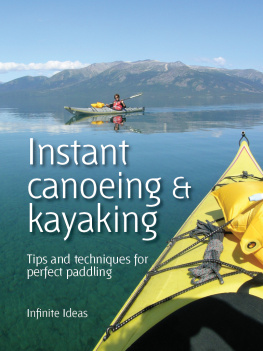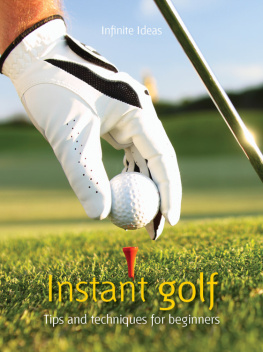Instant rock climbing
Tips and techniques for getting to the top
Infinite Ideas

Straight arm tactics

If you climb with your arms bent your muscles are going to start to hurt. The longer you keep climbing with arms bent the more fatigued your arms will become. So choose a fairly easy route and get a partner to advise you every time your arms are bent on the climb. That will create self awareness. Now, when on a climb proper and thinking of your next hand hold, bend your legs a little to move your body down until your arms straighten. Do this automatically. Your aim is always that your legs hold most of your weight on the rock. Strong legs are good, tired arms are not, so think constantly of positioning your body in such a way as to get your arms straight. The longer the time a climber spends with arms bent instead of straight, the more tired critical pulling muscles become.
Learn to turn

If you try climbing a rock face as if youre going up a ladder you waste a lot of energy and usually break the golden rule of keeping your arms straight as much as possible. You have to learn to climb so that your body moves from side to side and doesnt face the rock, so practice turning from side to side as you ascend. Have a climbing partner with you when going up a relatively easy route that has a lot of good holds. Practice turning your hips into the rock as much as possible. Your partner should tell you whenever youre too flat to the rock, and your aim is to alternate from side to side all the way up for each move. Its an exercise that will stretch you but the more you become used to turning on the rock the better your technique will become.
Rest assured 1

Climbing can be seen as a macho sport and sometimes the rock face can be difficult to climb because of spilt testosterone. Some climbers just want to attack the rock and try to get up it as quickly as possible through sheer brute force. Guess what? They tire towards the top, they end up deliberately avoiding routes that they should be able to make, and they start to make mistakes simply through exhaustion. Pick your rest spots before you start the climb and aim to rest every three metres or so. The rest spot may be obvious, like an overhang you can get your knee under or a ledge to lean against. So the more you regularly stop, the better your climbing technique will become.
Get a grip

Lots of new climbers squeeze too hard when theyre on the rock. All this will do is to tighten all the muscles in your arms and shoulders, preventing a fluid climbing motion. Its quite easy really: learn to relax your grip. Think of the grip not as the thing that keeps you cemented to the face but rather as the contact with the hold that helps you balance or when overhanging enables you to stay in place without expending too much energy. So grip with enough strength to keep you in place and remember, the perfect climbing motion is to be fluid and relaxed on the rock.
Static energy

Static climbing technique is the opposite, not entirely surprisingly, of dynamic climbing. In static climbing your body moves purely through muscle rather than momentum. What youre trying to do is avoid moving a limb and shifting weight at the same time. You should aim to move an arm or leg first, then shift your body weight. It sounds as if this would cause a jerky climbing motion but as you get better at it youll find you can absorb this in to a fluid movement. If you find that your feet are making a lot of noise on the rock it means youre not in control and therefore you need to work more on this aspect of your technique. Look for a hold rather than sliding your feet around speculatively and, when you do, make smooth motions with your feet until you reach it.
Dynamic climbing

When you use the momentum of your body to reach a move that is further than you can get to simply by moving your body through muscle power (static climbing) this is known as dynamic climbing. As always on the rock your movement should be fluid. Practising this will initially cause you some issues as you do have to learn to reach and trust your momentum to take you to the right spot, and your hands or feet to find a hold. But it is essential to practice this technique; start on a climbing wall initially.
Be a smoothie

How fluid you are on the rock face and the smoothness of your overall movements are really good indicators of how good a climber you actually are. A jerking, hurried, panicked motion, where you wiggle your feet or constantly try to reposition your hands, will mean that theres a greater likelihood of your falling or losing your balance. Plan each move in advance of making it, and resolve that its the only move youll make. If you focus, breathe properly as you move and practice, practice, practice your technique will improve.
Its a shoe in

Buying the right shoes for climbing is critical. They need to be comfortable on your feet and suit whatever climbing environment you need them for. So, firstly, go to a proper rock climbing shop where the staff are trained and try on at least three pairs, testing them on the wall in the shop. If the shop doesnt have a small wall for these purposes its not a proper climbing shop. If youre a beginner go for a shoe that has a hard sole. That will help with edging and smearing (smearing is where a maximum amount of friction from the sole keeps you attached to the rock). Go for shoes with laces rather than slip-ons. They are better for your feet as you can adjust them properly for maximum safety and fit. Finally, look after your shoes. They are an expensive investment so clean them properly and make sure you dry them out (no, not smack bang in front of the fire). Remember if they do get worn it may be possible to have them repaired so check out recommended specialists before investing in a brand new pair.
Smearing

Smearing is an essential skill to master quickly but many novice climbers find it rather intimidating. Essentially it is the practice of using as much as possible of the surface of the sole of your shoe to hold you against a flat rock face. Its all about the amount of friction between the rock and the shoe. Mastering it is great as it helps get your body weight on to your feet and legs and away from your arms. It requires good balance and is best used on slabs and other places where distinct holds are sparse. Types of rock on which smearing can prove particularly useful include gritstone, granite and sandstone.
Next page
























